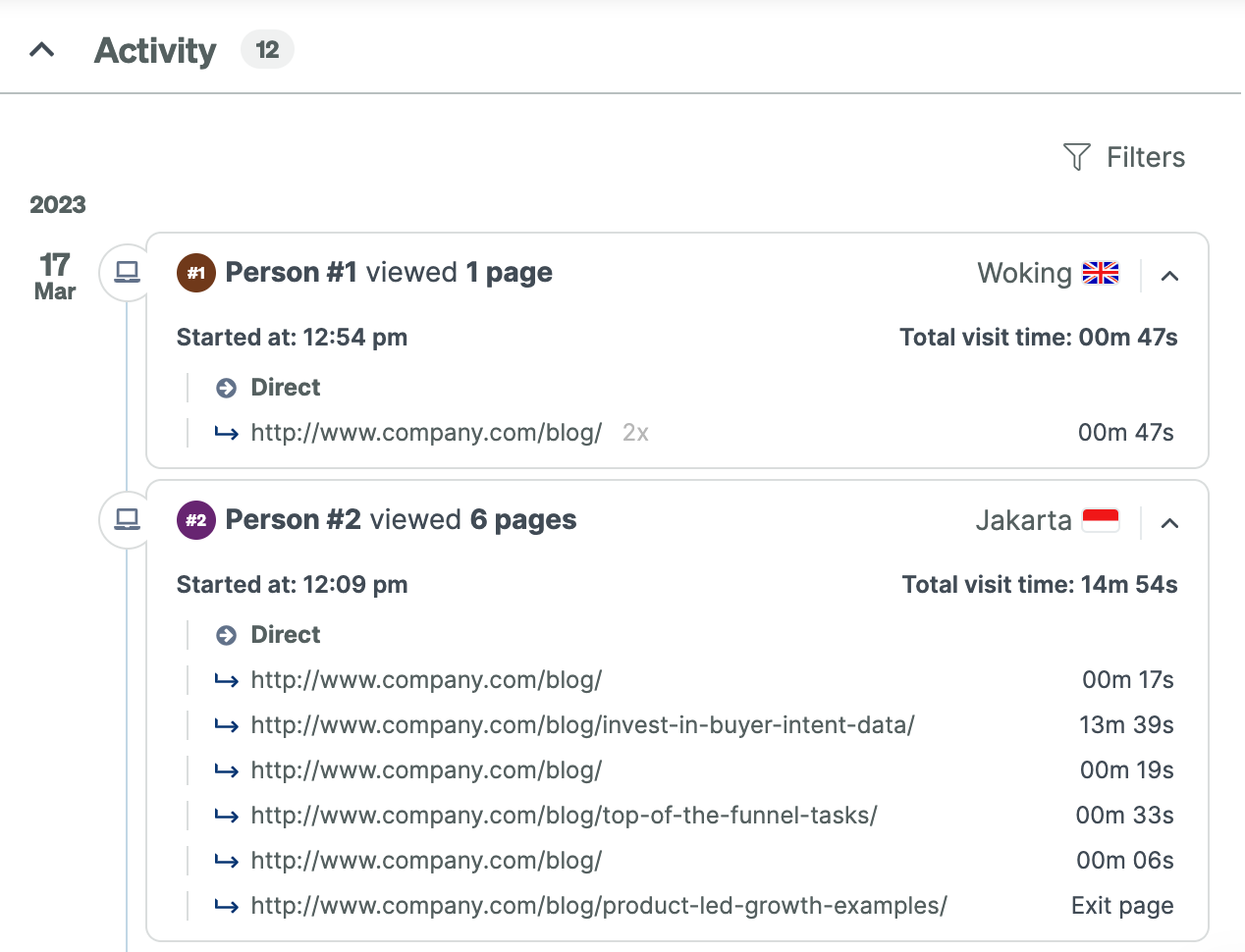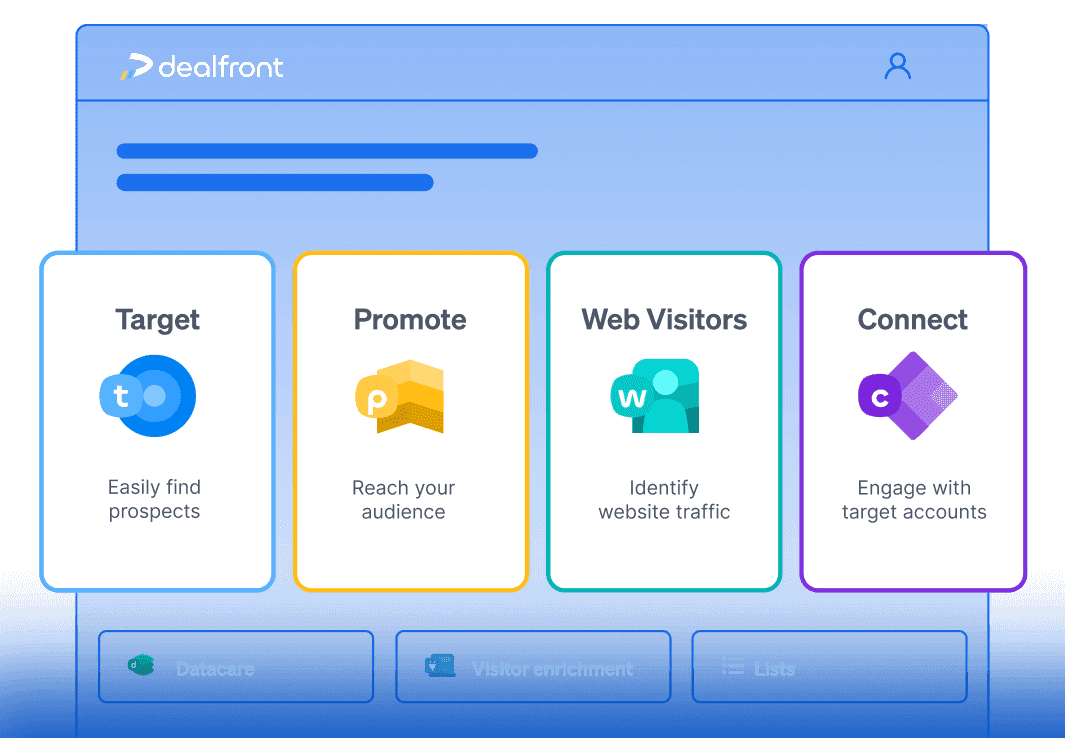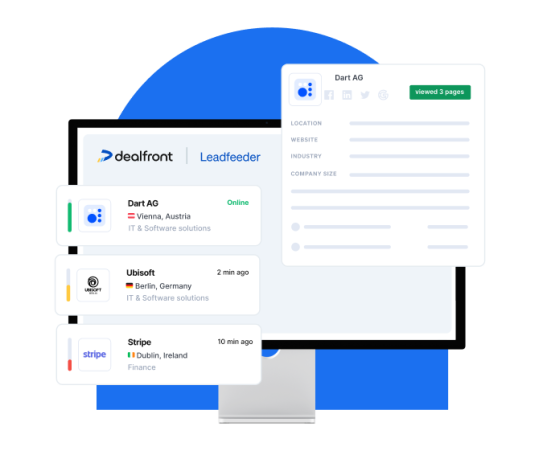
Recommended for
Sales Teams: Focus on reigniting past customer relationships to boost sales pipeline.
Customer Success Teams: Ideal for proactively reaching out to past customers to check on their needs and share updates.
Marketing Teams: For creating personalized campaigns targeted at past customers who have shown renewed interest.
Re-engaging past customers who revisit your website is more than a chance encounter; it’s an opportunity to reignite valuable relationships and explore fresh sales possibilities. When previous customers return, they’re signaling renewed interest or curiosity, providing you with an opening to strengthen your connection, address any evolving needs they might have, and introduce new products or services that could fit their goals.
This playbook will guide you in effectively identifying and re-engaging these high-potential visitors, helping you foster lasting partnerships and unlock new revenue opportunities.
Why is this signal so important?
Signals (also known as intent signals, trigger events, or sales triggers) are specific occurrences that signify a shift in a company’s priorities or interests, making them particularly receptive to outreach. When timed well, these events allow sales teams to approach prospects or previous customers when they’re most open to engaging with new products or services. Intent signals are invaluable in outreach because they add context and relevance, creating more meaningful and timely connections that lead to higher conversion rates.
One of the most significant signals is when past customers revisit your website. This action implies they have a renewed interest in your offerings, often signaling that their current needs have shifted, making them open to a fresh conversation.
Engaging with former customers who have already invested in your brand is usually more cost-effective than acquiring new clients, as they’re already familiar with your offerings and value. Re-establishing contact with these customers isn’t just about a one-time sale; it’s about deepening the relationship, creating more significant brand loyalty, and positioning yourself as a trusted, long-term partner in their success.
When past customers revisit your site, it provides a key opportunity to understand what has changed since your last interaction. Are they facing new challenges or looking to scale in areas they previously weren’t? This signal can open doors to cross-selling and upselling relevant products or services. If they initially left due to unmet needs, by addressing any previous gaps and demonstrating how your offerings have evolved can turn a missed opportunity into a new deal. Ultimately, this event allows you to reframe and tailor your offerings to meet their new objectives, giving you a second chance at closing the deal.
Re-engaging customers who revisit your site also allows you to reinforce your brand’s commitment to their growth and satisfaction. A proactive approach shows you’re paying attention and are ready to support them, building trust and signaling that their business is important to you. In turn, this level of engagement can foster loyalty and encourage customers to keep returning for your expertise, positioning your company as a valuable partner in their continued success. This approach makes it easier to connect with customers when they’re most receptive, maximizing the potential for revived sales and deepened loyalty.
How to identify past customers visiting your website?
Historically, knowing when a former customer returned to your website was nearly impossible. Without visibility into their engagement, sales teams could only guess when or if a lost customer might be interested again, often leading to missed opportunities or poorly timed outreach.
In many cases, churned customers would simply be cold-called at random times, resulting in outreach attempts that landed without context or relevance, leaving both the customer and sales team frustrated. With no reliable indicators, valuable leads could slip through the cracks, and promising conversations could fizzle out before gaining traction.
Today, with advancements in SaaS solutions and website tracking technology, sales teams are no longer left in the dark. By using IP data, these tools can now identify when a specific company or past customer visits your website. This technology flags returning visitors from your Ideal Customer Profile (ICP) or churned accounts list, providing real-time insights into renewed interest from them. With this data you can identify when a past customer or prospect is exploring your site, allowing for precisely timed outreach based on actual intent.
IP tracking technology also helps you determine which pages are being viewed, offering insights into what specific products or services are catching a past customer’s eye. For example, if a returning customer is exploring pricing pages or case studies, you can tailor your outreach with relevant content or updates. Rather than guessing, you’ll be reaching out with informed context, ensuring that every interaction is meaningful and well-timed.
Incorporating these SaaS solutions into your sales process gives you the visibility to re-engage at the right moment, making it easy to reconnect with past customers when their interest is freshly rekindled.
Step 1: Identify past customers
Use Leadfeeder by Dealfront to easily identify when a past customer visits your website.
1. Start by creating a list with your churned customers.
Option 1: to do this manually you will need to collate and input a list of all your previously churned customers.
Option 2: you can also download this data from your CRM and auto-create a list ready to use.
2. First, go to Leadfeeder and on the left-hand side click ‘+ Create custom feed’.
Next, on the right-hand side of the screen, click on ‘Filters’ and ‘Add a new filter’. In the ‘Search categories’ box type in and search for ‘Company list’ and set to ‘is’. In the next box along, then select ‘+Upload a list’.

3. A new window with the Datacare tab will open and you can upload your file via the “Company Importer” side tab.

4. Optional: You can add automation to this list to tag companies. Simply select the tag name ‘Churned’. By adding tags, it becomes much easier to filter by those tags, saving you time and improving your efficiency.

5. If you connect Dealfront with Slack, you can then set up Slack alerts to notify your Sales or Customer Success teams as soon as a past customer is identified on your site.
An alert is the quickest and easiest way of making sure you’re getting this news at the earliest opportunity. Timing is everything in sales, so having alerts set up will enable you to be extra punctual in reaching back out to the site visitor.
Select the option ‘When new companies appear’ from the ‘Frequency’ drop down list.

Step 2: Analyze website behavior
Once you've identified that a past customer has returned to your website, the next step is to analyze their browsing behavior to gauge their current interest. Begin by looking at the specific pages they visited. A visit to the pricing page, product updates, or relevant blog articles can indicate active interest and provide insights into their needs. For instance, a former customer exploring product updates may be curious about new features, while a focus on the blog suggests they might be seeking industry insights or evaluating your expertise.
Also, pay attention to intent events, such as multiple visits within a short timeframe or extended time spent on key pages.

If a past customer repeatedly visits high-interest areas like case studies, product demo requests, or the pricing section, these behaviors signal strong intent and a readiness to re-engage. This kind of data can help you prioritize outreach, allowing you to tailor follow-ups that align with their renewed interest and position you as a timely, relevant solution.
Step 3: Prepare a personalized outreach message
Once you’ve identified that a past customer has revisited your website, it’s time to craft a personalized message that speaks directly to their renewed interest. Begin by acknowledging your previous relationship; this helps establish familiarity and demonstrates that you value their past business. From there, consider highlighting any relevant updates since you last engaged. This could include recent product improvements, new features, or even updates to customer success stories that showcase how your offering has evolved.
Once you have determined which pages they have visited, use this information to tailor your message further. For example, if they explored specific product pages or case studies, mention any new developments related to those areas. This demonstrates that you’ve done your homework and are offering insights aligned with their apparent interests, making the message more relevant and impactful.
In the next section, you’ll find a message template to help you create a customized outreach email that effectively re-engages past customers while focusing on their potential current needs. Be sure to adapt it based on the information you’ve gathered to maximize engagement and encourage a warm reconnection.
Step 4: Execute the outreach
Email Outreach: Send a personalized email mentioning their interest based on the pages they visited. Provide helpful resources like demos, webinars, or case studies.
Sales Call: Follow up the email with a call or LinkedIn message, offering to discuss how your updated solution can solve their current challenges.
Automated Nurturing: If they don’t respond, place them into an email sequence designed for re-engaging past customers, showcasing new benefits and features.
Templates for Outreach
Email Outreach Templates
Email Outreach Templates
Subject Line: We noticed your recent visit—Exciting updates since we last connected!
Hi [Customer’s Name],
I hope you’re doing well! We noticed that you recently visited our website, and it was great to see your interest in [specific page visited, e.g., your product updates or pricing page]. Since our last collaboration, we’ve been working hard to enhance our offerings and wanted to share some exciting updates that could align with your current goals.
In particular, we’ve recently [mention any specific product improvements, new features, or success stories relevant to their interests]. We believe these changes could bring even more value to your team and support your continued success.
I’d love to reconnect and hear about any new initiatives on your end. Let me know if you’d be interested in a quick chat or if I can provide any additional resources—case studies, demos, or recent insights tailored to your needs.
Looking forward to catching up!
Best, [Your Full Name]
[Your Position]
[Your Company Name]
[Contact Information]
Hi [Customer’s Name],
It's been a while since you last spoke to [Your Company], but I noticed that someone from your company recently visited our website. So I thought this would be a good time to talk again.
From your past conversations with us, I hope you've learned how we can help you [company USP 1], and [USP 2].
Or, as in this case, to reconnect with old friends at a better time! Would this be such a time for you?
Best,
[Your Full Name]
[Your Position]
[Your Company Name]
[Contact Information]
Sales Call Template
Sales Call Template
Re-engaging a returning customer in a Sales Call. Acknowledge the customer’s recent visit, explore their current needs, and introduce relevant solutions or updates.
1. Opening (Build Rapport)
“Hi [Customer’s Name], it’s [Your Name] from [Your Company]. How have you been since we last connected?”
Note: Start with a warm, friendly tone. Acknowledge any prior positive experiences with them to establish familiarity.
“I noticed you recently visited our website, and it was great to see your interest in [specific page or product they viewed]. I thought it would be a good opportunity to check in and hear about what you’re currently working on.”
2. Acknowledge Their Interest and Ask Open-Ended Questions
“I’d love to understand if there’s anything specific that prompted you to explore our site again. Are there particular challenges or goals you’re focusing on right now?”
Tip: This question helps reveal their current needs and sets the stage for a tailored conversation.
“Since our last chat, we’ve actually made some exciting updates to [mention relevant product features, services, or customer success stories]. I’d be happy to dive into those if you’re interested.”
3. Discover Needs and Position Your Solution
Based on their response, adapt the conversation to focus on their current pain points and goals. Use the following prompts to steer the discussion:
“That’s great insight. Given that, I think you might be interested in [feature/product/service], especially since it addresses [mention specific need they referenced]. Would it be helpful to share how others in similar situations are leveraging it?”
Tip: Relate your solution directly to the challenges they shared, demonstrating empathy and understanding.
4. Offer Value and Relevant Next Steps
“I’d love to make this as valuable as possible for you. If you’re open to it, I could share a few case studies or set up a personalized demo based on what we discussed today. What do you think?”
Note: Offer options that don’t pressure but keep the conversation productive and focused on their benefit.
5. Closing (Set Up Future Engagement)
“I appreciate your time today, [Customer’s Name]. Whether you’re ready to re-engage now or down the line, I’m here to help you find the best fit for your needs. Feel free to reach out anytime, or let me know if you’d like to schedule that follow-up demo.”
Note: Leave the door open for future conversations without creating urgency. This approach is respectful and positions you as a reliable partner.
6. Follow-Up Email (After the Call)
Send a personalized email shortly after the call to summarize key points, share any resources promised, and confirm any next steps.
Step 5: Offer incentives
Offering an incentive can be a powerful way to revive the interest of a past customer. By presenting a tailored offer, such as an exclusive discount, free consultation, or a limited-time promotion, you give them a compelling reason to re-engage and explore a renewed partnership. This approach shows that you value their return and are willing to invest in helping them see the potential benefits of coming back on board.
Incentives not only make re-engagement more attractive but also give you a strategic way to stand out from the competition. Past customers already have familiarity with your brand, so a well-timed incentive can help overcome any initial hesitation they may have about re-engaging. When thoughtfully crafted to address their needs or interests, these offers reinforce the value you bring and signal your commitment to supporting their business growth.
What to do next?
After reaching out to a returning past customer with personalized messaging and an incentive, the next step is to focus on nurturing the relationship to deepen their engagement. Here’s how:
Follow up thoughtfully: after the initial message and offer, follow up in a timely and respectful manner. Use this opportunity to answer any questions, provide additional information, and reaffirm how your product or service can support their goals. Demonstrating genuine interest in their needs reassures them that they’re not just part of a generic outreach list.
Provide value-driven content: share relevant resources, case studies, or product updates that align with the customer’s interests or needs. This helps remind them of your expertise and keeps your brand top of mind without seeming too sales-focused.
Gauge interest: based on their responses, assess the level of interest and tailor the follow-up accordingly. For example, if they’ve engaged positively with your initial offer, suggest a demo or trial. If they’re not ready to fully commit, plan to touch base periodically, positioning yourself as a helpful resource.
Plan ongoing check-ins: add this customer to a nurture sequence or follow-up calendar so that you continue engaging them with updates, new offers, or relevant industry insights. This long-term approach builds trust and increases the chances of eventually converting them back into a loyal customer.
By following these steps, you’re building a pathway from initial re-engagement to a potential renewed partnership by offering ongoing value and personalized support.
Expected Results
By effectively reaching out to past customers who have revisited your website, you can anticipate several positive outcomes that not only drive sales but also strengthen your overall customer relationships:
Increase in repeat business: by reaching out to past customers who are already familiar with your product or service, you tap into a group with a higher likelihood of conversion. Re-engaged customers come with a foundation of trust, meaning they’re more likely to return as paying customers than completely new leads.
Shortened sales cycle: engaging with customers who already know your brand accelerates the sales process. With a reduced need for introductory conversations and brand education, you can move them through the funnel faster, making the entire sales cycle more efficient and freeing up time for your team to focus on other prospects.
Improved customer relationships: re-establishing contact with lapsed customers shows you value their business and care about their success. This effort can turn former customers into advocates, encouraging them to recommend your brand and paving the way for long-term loyalty and potentially expanded partnerships.
Each of these outcomes supports sustainable business growth, ensuring that your outreach efforts not only increase revenue but also reinforce the quality and longevity of customer relationships.
Subscribe to updates
Resources
Latest resources
MoreReady to grow your pipeline?







